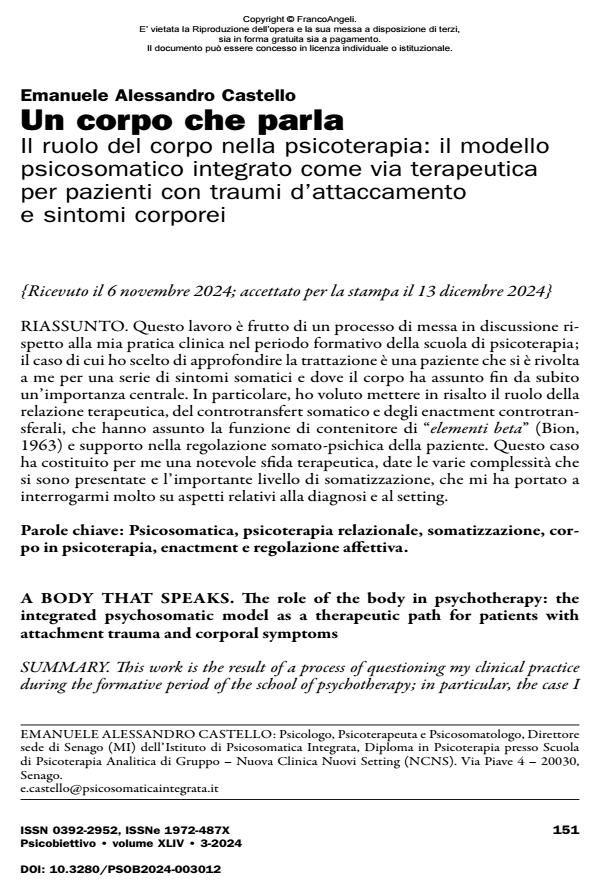A body that speaks. The role of the body in psychotherapy: the integrated psychosomatic model as a therapeutic path for patients with attachment trauma and corporal symptoms
Journal title PSICOBIETTIVO
Author/s Emanuele Alessandro Castello
Publishing Year 2025 Issue 2024/3
Language Italian Pages 14 P. 151-164 File size 171 KB
DOI 10.3280/PSOB2024-003012
DOI is like a bar code for intellectual property: to have more infomation
click here
Below, you can see the article first page
If you want to buy this article in PDF format, you can do it, following the instructions to buy download credits

FrancoAngeli is member of Publishers International Linking Association, Inc (PILA), a not-for-profit association which run the CrossRef service enabling links to and from online scholarly content.
This work is the result of a process of questioning my clinical practice during the formative period of the school of psychotherapy; in particular, the case I chose to study in depth is a patient who came to me for a series of somatic symptoms and where the body immediately assumed a central importance. In particular, I wanted to highlight the role of therapeutic relationship, somatic countertransference and countertransference enactments, which assumed the function of container of “beta elements” (Bion, 1963) and the function of support in the somato-psychic regulation of the patient. This case was a substantial therapeutic challenge for me, given the various complexities that arose and the important level of somatization, which led me to question myself a lot about aspects related to the diagnosis and the setting.
Keywords: psychosomatics, relational psychotherapy, somatization, body in psychotherapy, enactment and affective regulation.
- Alexander F. (1951). Medicina Psicosomatica. Firenze: Giunti-Barbera.
- Bateman A.W., Fonagy P. (2004). Il trattamento basato sulla mentalizzazione: psicoterapia con il paziente borderline. Milano: Raffaello Cortina Editore.
- Bion W.R. (1963). Elementi della psicoanalisi. Roma: Armando.
- Bowlby J. (1989). Una base sicura. Applicazioni cliniche della teoria dell'attaccamento. Milano: Raffaello Cortina Editore.
- Bromberg P. (2011). L'ombra dello tsunami. La crescita della mente relazionale. Milano: Raffaello Cortina Editore.
- Charmet G. Pietropolli (2000). I nuovi adolescenti. Milano: Raffaello Cortina Editore.
- Craparo G. (2015). Inconsci, coscienza e desiderio. L'incertezza in psicoanalisi. Roma: Carocci.
- Craparo G. (2017). L'enactment nella relazione terapeutica. Caratteristiche e funzioni. Milano: Raffaello Cortina Editore.
- Fonagy P., Target M. (1997). Attaccamento e funzione riflessiva, Milano: Raffaello Cortina Editore.
- Freud S. (1892-95). Studi sull'isteria. In: OSF, vol. 1. Torino: Bollati Boringhieri, 1977.
- Freud S. (1895). Legittimità di separare dalla nevrastenia un preciso complesso di sintomi come "nevrosi d'angoscia". In: OSF, vol. 2. Torino: Bollati Boringhieri, 1977.
- Freud S. (1915). Metapsicologia: Pulsioni e loro destini; La rimozione; L'inconscio.
- In: OSF, vol. 8. Torino: Bollati Boringhieri, 1978.
- Freud S. (1922). L'Io e l'Es. In: OSF, vol. 9. Torino: Bollati Boringhieri, 1977. Kernberg O.F. (1984). Disturbi gravi della personalità . Torino: Bollati Boringhieri. Lacan J. (1960-1961). Il seminario, libro VIII: Il transfert. Torino: Einaudi.
- Lacan J. (1960). Sovversione del soggetto e dialettica del desiderio nell'inconscio freudiano. In: Scritti. Torino: Einaudi.
- Mucci C. (2020). Corpi borderline. Regolazione affettiva e clinica dei disturbi di personalità . Milano: Raffaello Cortina Editore.
- Ogden P. (2012). Il trauma e il corpo. Manuale di psicoterapia sensomotoria. Milano: ISC Editore.
- Schore A.N. (2022). Psicoterapia con l'emisfero destro. Milano: Raffello Cortina Editore.
- Scognamiglio R.M. (2008). Il male in corpo, Milano: FrancoAngeli.
- Scognamiglio R.M. (2016). Psicologia psicosomatica. L'atto psicologico tra codici del corpo e codici della parola, Milano: FrancoAngeli.
Emanuele Alessandro Castello, Un corpo che parla Il ruolo del corpo nella psicoterapia: il modello psicosomatico integrato come via terapeutica per pazienti con traumi d’attaccamento e sintomi corporei in "PSICOBIETTIVO" 3/2024, pp 151-164, DOI: 10.3280/PSOB2024-003012